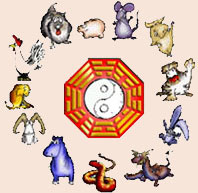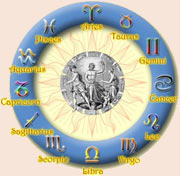Modern Facts of the Nine Planets
Astrology (East and West)
 |
Astrology appeared circa 4000 B.C. in Assyria, Babylon, China, and India. The Egyptians used astrology for purposes of divination and employed high priests as astrologers from 2000 B.C.
The Greeks were teaching astrology from 800 D.C. and, through Egyptian influence, were active in Rome around 100 B.C.
Astrology spread along with Christianity into Byzantium and returned to Europe in the middle ages. It was also popular in other ancient cultures, such as that of Mexico. After an eclipse following the march of "Science" (except in countries like India where it never lost popularity), astrology has staged a remarkable come back since 1900 practically throughout the world.
The Zodiacs
The Sun moves along a great celestial circle called the Ecliptic (unfortunately the orbit of the earth defines a plane which also is called Ecliptic by some) inclined 23.5 degrees to the celestial equator. The band centred around this Ecliptic is the region where the planets travel and the 12 constellations inscribed.
This glittering belt was called the zodiac by the Greeks and its 12 constellations gave their names to the 12 zodiacal signs used in astrology even today.
 |
The assumption in astrology is that the earth is a fixed point and all other cosmic bodies revolve around it once a day. This 24-hour system is applied with two hours allocated to the 12 members of the zodiac (a 30degree arc allocated to each zodiacal sign).
The zodiac is an imaginary star path through which the planets travel. Its origin has been the subject of speculation among astronomers.
There are two zodiacs--the Tropical Zodiac, used mostly by astrologers using the Western system, and the Sidereal Zodiac, used in India by most astrologers (also called Jyotisha or Vedic system). Roughly 2,000 years ago the two zodiacs coincided (during age of Aries, that is when Sun rose In Aries) but as Tropical Astrology ignore~ precession (and Sidereal Astrology tries to take it into account though the rate of precession is subject to various questions) the two zodiacs have been moving apart 50 seconds every year.
The Tropical system shows astronomical positions 2,000 years ago and the star signs no longer are synchronous with signs of the zodiac. Tropical Astrology is essentially Involved in Sun-Earth relationships while Sidereal Astrology calculates relationships between the Solar system, the fixed stars and, according to some, the galaxy itself.
However, if the rate of movement of precession (called Ayanamsha) is used and subtracted from the tropical chart, the result is a sidereal chart. Because of this, as well as the fact that it is easier to describe as well as understand, we will describe things based on Tropical astrological charts in the rest of the chapter.
These glyphs or symbols for the planets and zodiacal components are used in the birth chart and in the 12 houses chart~ used in interpreting the birth chart. We use the equal house chart technique as it is easier to explain and communicate with.
The Twelve Houses
Basically the planets occupying the 12 houses and their aspects and relationships determine the personality and the various happenings in the life of an individual. Ephemeris tables (which provide the locations of the planets and components of the zodiac) can be used to predict the future events in one'~ life. This can also be used to predict the fate of countries, relationships, such as marriages, best times for auspicious events, such as buying a new home, ete.
The Effects of Planets
We now briefly indicate the effects of planets in particular houses according to astrology. In this aspect, there is very little difference between Western and Indian astrology (though differences between Tropical and Sidereal schemes can result in their being in different houses). The number corresponds to the house number also.
1. The first house, also the rising Sun, corresponds to Aries and affects what is unique about an individual.
2. The second house relating to conservative Taurus shows what is of value to the person.
3. Curious Gemini governs style and manner of communication as well as sibling relationships.
4. Influenced by nurturing and domestic environment, Cancer shows how one views and seeks security.
5. Artistic Leo governs creativity.
6. Analytical Virgo affects health and work.
7. Libra influences feelings about dose relationships.
8. Intensely emotional Scorpio influences the entire life processes from birth to death.
9. This is the house of religion and philosophy (related to the wandering Sagittarius).
10. Aspiring Capricorn influences ambition and desire.
11. Free thinking Aquarius rules creativity in social situations and interactions with groups and individuals.
12. Sensitive, vulnerable Pisces relates to self-sacrifice, and service to others as also the need for seclusion.
In terms of western astrology the Uranian influence is claimed to be the major factor in his horoscope

